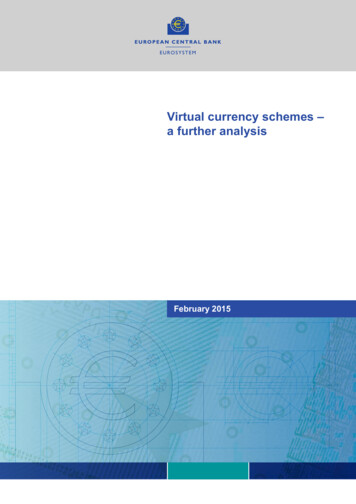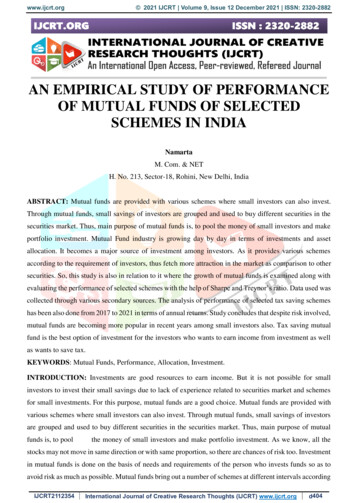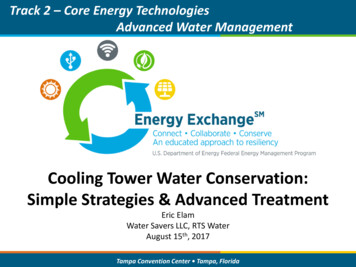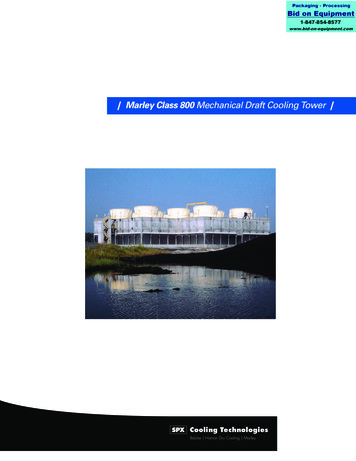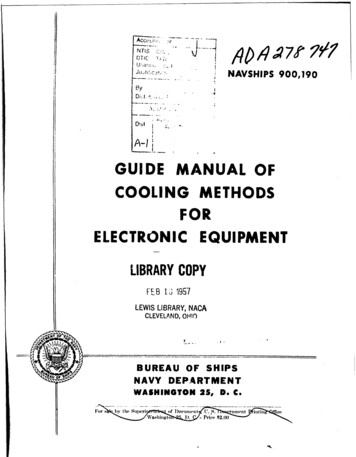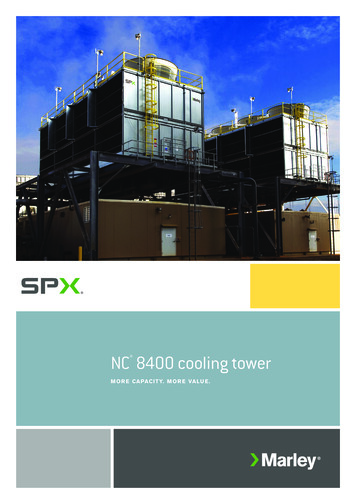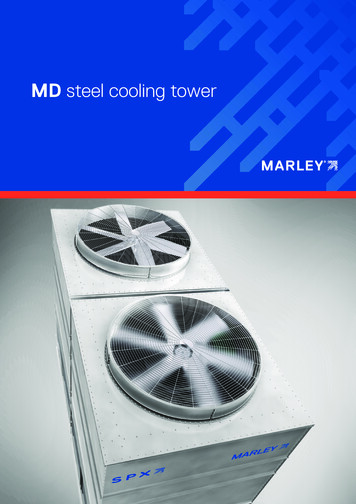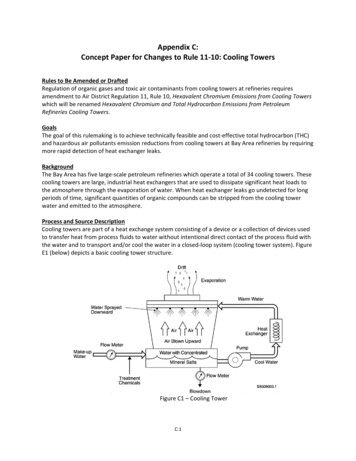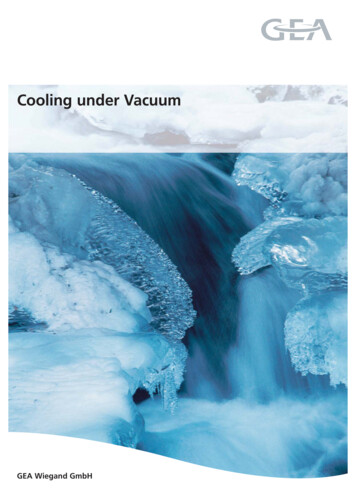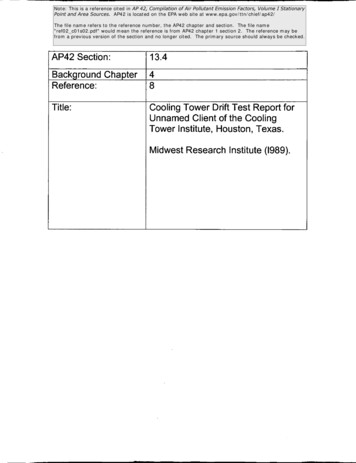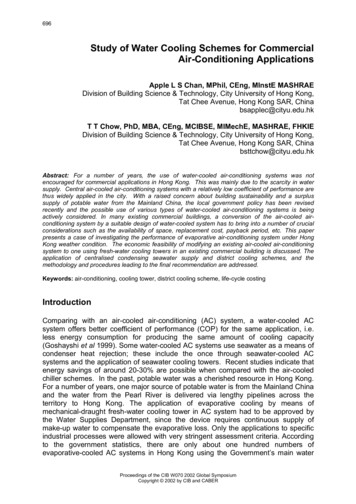
Transcription
696Study of Water Cooling Schemes for CommercialAir-Conditioning ApplicationsApple L S Chan, MPhil, CEng, MInstE MASHRAEDivision of Building Science & Technology, City University of Hong Kong,Tat Chee Avenue, Hong Kong SAR, Chinabsapplec@cityu.edu.hkT T Chow, PhD, MBA, CEng, MCIBSE, MIMechE, MASHRAE, FHKIEDivision of Building Science & Technology, City University of Hong Kong,Tat Chee Avenue, Hong Kong SAR, Chinabsttchow@cityu.edu.hkAbstract: For a number of years, the use of water-cooled air-conditioning systems was notencouraged for commercial applications in Hong Kong. This was mainly due to the scarcity in watersupply. Central air-cooled air-conditioning systems with a relatively low coefficient of performance arethus widely applied in the city. With a raised concern about building sustainability and a surplussupply of potable water from the Mainland China, the local government policy has been revisedrecently and the possible use of various types of water-cooled air-conditioning systems is beingactively considered. In many existing commercial buildings, a conversion of the air-cooled airconditioning system by a suitable design of water-cooled system has to bring into a number of crucialconsiderations such as the availability of space, replacement cost, payback period, etc. This paperpresents a case of investigating the performance of evaporative air-conditioning system under HongKong weather condition. The economic feasibility of modifying an existing air-cooled air-conditioningsystem to one using fresh-water cooling towers in an existing commercial building is discussed. Theapplication of centralised condensing seawater supply and district cooling schemes, and themethodology and procedures leading to the final recommendation are addressed.Keywords: air-conditioning, cooling tower, district cooling scheme, life-cycle costingIntroductionComparing with an air-cooled air-conditioning (AC) system, a water-cooled ACsystem offers better coefficient of performance (COP) for the same application, i.e.less energy consumption for producing the same amount of cooling capacity(Goshayshi et al 1999). Some water-cooled AC systems use seawater as a means ofcondenser heat rejection; these include the once through seawater-cooled ACsystems and the application of seawater cooling towers. Recent studies indicate thatenergy savings of around 20-30% are possible when compared with the air-cooledchiller schemes. In the past, potable water was a cherished resource in Hong Kong.For a number of years, one major source of potable water is from the Mainland Chinaand the water from the Pearl River is delivered via lengthy pipelines across theterritory to Hong Kong. The application of evaporative cooling by means ofmechanical-draught fresh-water cooling tower in AC system had to be approved bythe Water Supplies Department, since the device requires continuous supply ofmake-up water to compensate the evaporative loss. Only the applications to specificindustrial processes were allowed with very stringent assessment criteria. Accordingto the government statistics, there are only about one hundred numbers ofevaporative-cooled AC systems in Hong Kong using the Government’s main waterProceedings of the CIB W070 2002 Global SymposiumCopyright 2002 by CIB and CABER
697supply. There are about another one hundred once-through seawater-cooled ACsystems that serve public and commercial buildings. These are installed at buildingsclose to the seafront, and have dedicated seawater pumping stations and pipelinesfor AC heat rejection. In some other buildings near the seafront however, air-cooledheat-rejection systems are still used because the investments can be lowered. Hencethe use of air-cooled AC systems has been dominating in the public and commercialsectors throughout the city.With the growing concerns about energy saving, building sustainability and, at thesame time, a record of over supply of potable water from the Mainland China, a wideruse of evaporative-cooled and water-cooled AC systems has been called for.Building professionals urged the relaxation of using fresh-water cooling towers innewly designed AC systems. In 1999, a government study (HKSAR Government1999) concluded that the economic and environmental benefits of adopting watercooled AC systems on a wider basis in Hong Kong are substantial. Three differentschemes of water-cooled AC systems with good potentials have been identified.These are:1. Centralized piped seawater supply system that consists of a central supply oflarge quantity of seawater to a number of buildings via pumping station forcondenser cooling.2. Centralized piped supply system for cooling towers, that is a similar infrastructurearrangement to the above; however, this involves the supply of a much smalleramount of seawater or freshwater to the buildings.3. District cooling scheme (DCS), that comprises a large central chiller plant locatedwithin close proximity of the buildings (or district) being served.In a centralized piped seawater supply system, seawater is supplied to the airconditioning plant of the individual building through an underground distributionpiping network. It is a capital intensive infrastructure development. Energy andeconomic benefits must be justified before implementation. Other than the advantageof installing less number of seawater pumps because of the diversity factor, theeconomy of scale lies in the use of large seawater pumps. This is not so attractive asthe use of huge chillers in DCS, of which the COP can be much higher than themedium-size chillers.Technically speaking, the location, development and implementation of the aboveschemes will be largely dependent on the physical area or district where the schemeis to be employed. It will be much simple to implement these in new developing areasthan in existing urban areas. In many existing commercial buildings, a conversion ofthe air-cooled AC system by a suitable design of water-cooled system has to bringinto a number of crucial considerations such as the availability of space, replacementcost, payback period, etc. The methodology and procedures adopted to produce thefinal recommendation also have to be explored. In the role of a facilities manager,there is a need to study the technical feasibility and financial implication of modifyingan existing air-cooled AC system, during the building retrofit work, to an evaporativeAC system with cooling towers. In the following sections, a study of the saidmodification work based on real building data is first introduced. Then a methodologyof evaluating DCS is discussed. Computer simulation has been found very useful inthese analyses.Study of Water Cooling Schemes for Commercial Air-Conditioning ApplicationsChan, A.L.S. and Chow, T.T.
698Modification of Existing Air-Cooled Air-Conditioning SystemIn this study, real data of an existing commercial building installed with an air-cooledair-conditioning plant was used. This is a 20-storey curtain wall commercial buildingwith a window-to-wall ratio of 40%. There are ten nos. of chillers: two 100 TR, one175 TR and seven 200 TR in the hydronic circuit with differential pressure bypasscontrol. A building management system (BMS) is provided and recorded theoperating data of the AC system, such as hourly chilled water flow rate, chilled watertemperatures, electricity consumption of major equipment, etc.A transient plant simulation program TRNSYS was used to model and simulate theoperation of the AC system. The modelling flow chart is shown in Figure 1 below. Aset of 8,760 measured hourly weather data for the year 1989 in Hong Kong was usedfor the simulations of respectively air-cooled and evaporative-cooled (with fresh-watercooling tower) AC plants. The year 1989 has been worked out to be the TestReference Year (TRY) of Hong Kong, which represents the prevailing weatherconditions regarding comparative energy study (Hui & Lam 1992). The evaporativecooled AC plant configuration developed through TRNSYS is shown in Figure 2. Withthe hourly building cooling loads derived from the BMS recorded data, themonthly/annual electricity consumption of each AC plant was simulated. Economicanalysis was then conducted. Life-cycle cost and pay back period were alsodetermined.EstimatedCooling loadHong KongWeather DataTRNSYS(HVAC PlantSimulation)(HVAC Plant ElectricityConsumption)EconomicAnalysisFigure 1 Modelling Flow ChartStudy of Water Cooling Schemes for Commercial Air-Conditioning ApplicationsChan, A.L.S. and Chow, T.T.
699Figure 2 Air-Conditioning Plant Configuration in TRNSYS400,000300,000kWh 00S1Figure 3 Simulated Monthly Electricity Consumptionsof Air-Cooled and Water-Cooled AirConditioning SystemsFigure 3 shows the simulated monthly electricity consumptions of the two ACsystems. Series 1 shows the electricity consumptions of the evaporative-cooled ACsystem and series 2 shows that of the air-cooled AC system. The evaporative-cooledAC is found more energy-efficient. The percentage in saving ranges from 12.35% inFebruary to 17.1% in August. The annual saving is 15.6%.Study of Water Cooling Schemes for Commercial Air-Conditioning ApplicationsChan, A.L.S. and Chow, T.T.
700Economic Feasibility AnalysisLife-cycle costing technique was used to investigate the economic feasibility ofmodifying an existing air-cooled air-conditioning system to an air-conditioning systemwith cooling tower in existing buildings (Charette 1980). Due to inflation and marketdiscount rate, net present value (NPV) of the total electricity cost over the life cycle ofthe air-conditioning plant has to be calculated. This is expressed as:p (EC )n 1n 1 i EC n 1 1 d pn 1(1)whereECid 1 i 1 d electricity cost in the first yearescalation rate of electricity costmarket discount rate discounting factorn 1and the pay back period is calculated by: 1 I (1 ID 1) ln ID EC1 EC 2 P 1()IDln (2)whereID I 1 i 1 d investment for plant modificationAn average escalation rate of electricity of 3.55% and a market discount rate of5.69% (HKSAR Government 2000) were used. The electricity tariff in Hong Kong isabout HK 0.95 per kWh (1 GBP HK 12 approximately). Based on the simulatedresults, the annual saving in electricity cost was found HK 493,600 after theconversion. The life cycle of the modified plant is 25 years, and the correspondingcost is HK 3,800,000; these are provided by a licensed air-conditioning contractorfirm. Based on the mentioned life-cycle model, the pay back period of the conversionis found about 8 years, and the net saving in electricity cost is HK 5,960,600throughout its operating life. It can be seen that both the payback period and the netsaving are reasonable, from the building owners point of view.District Cooling SchemeIn a district cooling scheme, chilled water is circulating between a centralized chillerplant and a district comprising multiple buildings or facilities, through closed-loopStudy of Water Cooling Schemes for Commercial Air-Conditioning ApplicationsChan, A.L.S. and Chow, T.T.
701underground piping network. The economical advantage of DCS mainly comes fromthe diversity factor in which the total installed cooling capacity at the centralised plantis smaller than the sum of individual plants at the consumer buildings based onconventional design. DCS thus offers massive and collective cooling energyproduction, which is higher in efficiency than individual cooling energy production.On the other hand, DCS consumers are not required to install their own chiller plantsand thus can utilise building space more effectively. Moreover, operating costadvantage can be achieved by shifting power consumption of electric-type chillersfrom daytime to night by the use of thermal storage, hence cutting powerconsumption in the peak hours. A systematic approach to evaluate the feasibility of aDCS is illustrated below.Thermal Load ModellingThe methodology for developing thermal load profiles, central plant design, andoperation arrangements was introduced herewith, making reference to a new districtin Hong Kong. The process is indicated in a flow chart shown in Figure 4.In the process, the buildings to be served by the DCS are grouped into a number ofcategories, such as office, shopping arcade, hotel, hospital, etc. Of each category,model buildings are developed to represent the typical conditions within the district.These include the appropriate building materials, configuration, floor area,occupancy, operating schedule, etc. The hourly cooling load profiles of each modelbuilding during the whole year (or only the summer months for simplicity) aredetermined using a cooling load estimation tool, like the HEVACOMP or CARRIERsoftware. The computation is based on the cooling load design weather data of HongKong. Three daily schedules are involved: weekday, weekend and holiday types. Bythese the normalized design load profiles of each category expressed in terms ofcooling load intensity (CLI) in W/m2 are determined. For a development site with nnumbers of building categories, the hourly district cooling load profile, the DCL matrix(with elements in MW) can be determined as illustrated in Figure 5. A1 to An in theequation represent the gross floor area of each building category. DCLmax is thepeak value sorted from the DCL matrix elements and is the required cooling capacityof the DCS plant, i.e. the total installed capacity.Figure 6 shows the weekday design cooling load profiles for different building typesof the selected new district in Hong Kong. Based on the gross floor areas for eachtype of building, the peak cooling load without diversity is estimated as 261 MW,while the peak cooling load for the whole district is 193 MW when the DCS is applied.The corresponding diversity factor is 0.74.Similarly, the 8,760 hourly thermal load profiles for various typical buildings indifferent categories during the Test Reference Year can be obtained through the useof a dynamic simulation program. In our case, the DOE-2 energy simulation softwarewas used.Study of Water Cooling Schemes for Commercial Air-Conditioning ApplicationsChan, A.L.S. and Chow, T.T.
702Thermal LoadSimulationby DOE-2GFA (m2) for EachBuilding Categoryin Each Site AreaYear-round Hourly Cooling &Heating Load Database (W/m2)for Each Building CategoryThermal Load Database(Hourly, Monthly & Yearly)Weather andEnvironmentalDatabaseHourly WeatherDatabaseThermal LoadAnalysis on TypicalBuildingsDCS Scheme Configuration& Equipment Sizing withOptionsSystem Simulation on DCSEnergy Consumption(Hourly, Monthly & Yearly)DCS EnergyPerformance AnalysisCost AnalysisPlant Simulationby TRNSYSFigure 4 Thermal Load and Plant Simulation Modelling Flow ChartStudy of Water Cooling Schemes for Commercial Air-Conditioning ApplicationsChan, A.L.S. and Chow, T.T.
703 CLI 3,1 CLI 2,1 CLI 1,1 M M M M MM M A3 . A2 M A1 M MMM M M M CLI CLI CLI1,8760 2 ,8760 3,8760 DCLn ,1 CLI n ,1 MM MM MM An MM MM DCL CLIn ,8760 n ,8760 DCLmaxFigure 5 Determination of Hourly and Peak Cooling Loads in a District90Office80Police70Factory60Game 10Retail01357911131517192123StationFigure 6 Weekday Cooling Load Profiles for Various Building CategoriesPlant ModellingIn plant simulation, the TRNSYS software had been used for estimating the annualelectricity consumption through a “quasi” steady-state simulation of discrete hourlydata of the system operation. Figure 7 shows the proportion of the energyconsumption at the four main system components, namely the chillers, the productionpumps, the distribution pumps, and the seawater cooling pumps. In DCS, the chilleris the major power consumer and can consume up 70 to 80% of the total electricenergy supply. The percentage shares of the distribution pumps and the seawatercooling pumps depend very much on the size of the distribution network as well asthe seawater intake and discharge locations.Study of Water Cooling Schemes for Commercial Air-Conditioning ApplicationsChan, A.L.S. and Chow, T.T.
704Productionpumps4%DistributionpumpsSeaw ater13%Cooling pumps12%Chillers71%Figure 7 Percentage of Electricity Consumption in a DCSSystem simulation exercises can be extended for a mix of central plant facilities anddistribution loop configurations. The decision on potential DCS options must bringinto consideration a series of plant operating strategies, as well as other physicalconstraints imposed by the civil work, the social, business and legal environment etc.The output of the energy model, i.e. year round hourly data of the electricity (andother fuels if any) consumption profiles, can be transferred to the cost model toanalyse the annual operation costs under different tariff structure. The cost modelthus needs to compare costs of each option with the revenue flows that could beexpected by potential DCS operators. Costs and revenues are to be compared withinthe options for a regulatory framework to protect DCS customers.Discussion and ConclusionsThere is a global concern about energy conservation - the lesser we consume, the“greener” environment we can have due to lesser pollutants produced. Airconditioning, the largest electricity-consuming item in commercial buildings, accountsfor about 50 to 60% of the total building electricity consumption in Hong Kong (Chan1994). In most commercial buildings in Hong Kong, air-cooled air-conditioningsystems are installed. It is needed to look severely into the energy savingopportunities by applying the water-cooled technology in condenser heat rejection.The possibility of a wider application of water-cooled air-conditioning systems hadbeen discussed. The feasibility of modifying an existing air-cooled air-conditioningsystem to an evaporative-cooled air-conditioning system has been investigated. Inthe present study, it is found that the modification is both technically andeconomically viable. Issues including prevention of legionnaire disease, interruptionto building operation during modification of air-conditioning plant, space required, etc.should be further investigated.Also introduced is the methodology that can be used in the feasibility study of districtcooling system. The process involves a sequence of building design loadcomputation, building dynamic simulation, and plant energy consumption analyses.Identifying the optimum DCS plant configuration actually involves the determinationof the optimum locations of the seawater intake and discharge, the locations of thecentral plant and main distribution pipes, etc. This should be further exploredStudy of Water Cooling Schemes for Commercial Air-Conditioning ApplicationsChan, A.L.S. and Chow, T.T.
705(Babus’Haq et al 1987, Nagaiwa et al 1995). The task can be extended to study thevarious options which will optimise the cost effectiveness of the DCS scheme such asco-generation or tri-generation, thermal storage, low temperature chilled waterdistribution, the possible use of phase change materials, ice-water slurries, etc.Various optimisation techniques such as dynamic programming and geneticalgorithm (Sakamoto et al 1998) can be used in the above studies.AcknowledgementThe work here is supported by the Strategic Research Grant (Project No. 7001192)from the City University of Hong Kong.ReferencesBabus’Haq, R.F., Probert, S.D. and Shilston, M.J., Optimal configuration for horizontal double-pipedistrict heating/cooling distribution networks, ASHRAE Transactions, 160-175, 1987.Chan, Lok Shun Apple, Development of Guidelines for Energy-Efficient Operation of Fully AirConditioned Buildings in Hong Kong, MPhil Thesis, City University of Hong Kong, June 1994.Charette, R.P., Life Cycle Cost Analysis for Buildings, ASHRAE Transactions, Vol.86, Part 2, 167-183,1980.Goshayshi, H.R., Missenden, J.F. and Tozer, R., “Cooling tower – an energy conservation resource”,Applied Thermal Engineering, Vol. 19, 1223-1235, 1999.HKSAR Government, Economic Background, Economic Services Bureau, Government Secretariat,2000.HKSAR Government, Hong Kong Energy Statistics – Annual Report, Census and StatisticsDepartment, 2000.HKSAR Government, Preliminary Phase Consultancy Study on Wider Use of Water-cooled Airconditioning Systems in Hong Kong, Final Report, Electrical & Mechanical Services Department,1999.Hui, S.C.M. and Lam, J.C., Test Reference Year for Comparative Energy Study, Hong KongEngineers, Vol.20, No.2, 13-16, 1992.Nagaiwa, A., Kobayashi, S., Sakamoto, Y., Nakamaru, T. and Inaba, M., Optimization of districtheating and cooling plant operation by utilizing unused energy, National convention record IEEJ,Vol. 4, 351-352, 1995.Sakamoto, Y., Nagaiwa, A., Kobayashi, S., Shinozaki, T. and Imazu, T., GA applied operationsupporting system of heat pump plant with thermal storage tanks, Proceedings of the 25th ArtificialSystem Symposium of SICE, 1-6, 1998.Study of Water Cooling Schemes for Commercial Air-Conditioning ApplicationsChan, A.L.S. and Chow, T.T.
modifying an existing air-cooled air-conditioning system to an air-conditioning system with cooling tower in existing buildings (Charette 1980). Due to inflation and market discount rate, net present value (NPV) of the total electricity cost over the life cycle of the air-conditioning plant has to be calculated. This is expressed as: () 1 1 1 1 .
